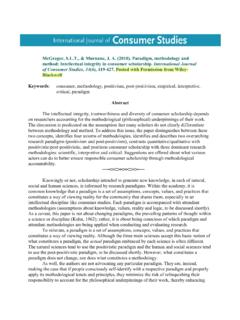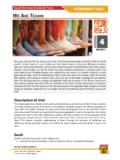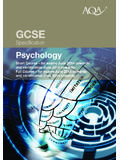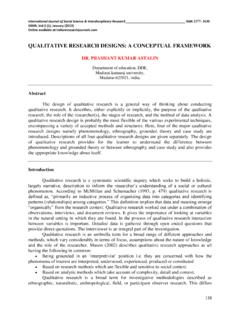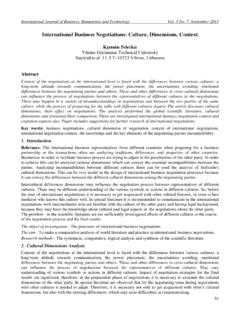Transcription of Well-being, Wellness and Basic Human Needs in …
1 well -being, Wellnessand Basic Human Needsin Home EconomicsMcGregor Monograph Series No. 201003 October 18, 2010 Sue L. T. McGregor PhD ProfessorDocent in Home Economics University of HelsinkiDoctoral Program Coordinator, Faculty of Education Mount Saint Vincent University Halifax NS 902-823-2625 NOTE - this monograph was inspired by Monograph No. 201002, which deals with positioning the humancondition concept within home economics. Although there are similarities in content, No. 201002 provides avery detailed discussion of Hanna Ardent s theory of the Human condition.
2 This monograph focuses muchmore detail on well -being, Wellness and Basic Human Needs . As well , whereas several American initiatives werewoven into the story shared in No. 201002, they are individually analyzed in this monograph for evidence oftheir usage of these concepts during the last 20 For over a century, home economists have consistently claimed that the profession smission it to optimize the quality of life and well -being of individuals and families. Somepractitioners also describe the profession s raison d etre as enhancing Wellness and, morerecently, achieving Basic Human Needs ( , Nickols et al.)
3 , 2009). The first premise of thismonograph is that these three concepts, although related, can be clearly distinguished. Thesecond premise is that the profession should augment its focus on well -being and Wellness withtheories of Basic Human Needs so that it can begin to see the Human condition as its raison d second premise is predicated on two assumptions. First, the standard concepts ofwell-being and Wellness , as home economics understands them, are too limiting to address thepressing, complex, global issues facing humanity.
4 Second, the concept of Basic Human needsbrings us closer to a concern for the Human condition (Brown, 1993). East (1979) proposed thathome economists should focus on the home and family for the good of humanity. If theprofession does not give the Human condition the emphasis it deserves, it cannot attend to theproblems and opportunities that the Human condition inevitably will pose, problems that deeplyimpact family well -being, Wellness and the ability to meet Basic Needs : poverty, unequal incomeand wealth distribution, insecurity, violence and conflict, injustices, unsustainability, and unevendevelopment (McGregor, 2010).
5 To develop this idea, the monograph is organized into four sections. Section one providesgeneric definitions of each concept generated outside the home economics profession. Althoughwe are not the only profession to employ these concepts in our practice, we have engaged inseveral key initiatives either directly or indirectly related to their role in home economics. Sectiontwo profiles eight such American initiatives undertaken during the last 20 years. Each enterpriseis analysed to determine its architects references to well -being, Wellness , Basic Human Needs ,and the Human condition.
6 In an attempt to generate insights to inform international conversations,section three provides a friendly critique of these initiatives. Section four offers a four-prongedapproach that integrates leading-edge versions of well -being, Wellness and Human Needs , with thehuman condition as the anchor - the highest order a caveat, the author deeply respects the collective intellectual efforts behind each ofthe eight American initiatives. The overall critique is not criticism; no offense or disrespect isintended. Observations serve only to illustrate evidence, or the potential, of conceptual migrationtowards higher and deeper ideas.
7 Indeed, the author holds the architects of these theoretical andconceptual innovations in extremely high regard; they are all pioneers in their own right. Thismonograph strives to bring their ideas together for the first time, juxtaposed against each other asa means of shedding light on their intellectual and philosophical contributions to, what havebecome, anchor concepts for the profession. It will become evident that intellectual progress vis- -vis these conceptual contributions is readily evident over the last 20 years in the United States, paving the way for future innovations at the international level.
8 Page 2 of 31 Generic Conceptualizations of well -being, Wellness and Basic Human NeedsThis section shares generic conceptualizations and theoretical innovations for each ofwell-being, Wellness and Basic Human Needs developed outside the field of home merit investigation because they have, continue to or have the potential to, informconceptual innovations in home economics, especially towards a focus on the Human condition. well -beingThe concept of well -being is very broad and diverse. The particular approach adopted todiscuss well -being reflects both the purpose of the initiative as well as any disciplinary andtheoretical perspectives (King, 2007).
9 A new initiative of the Canadian government (HumanResources and Skills Development Canada, 2010) conceptualizes well -being as comprising 10areas: learning, work, leisure, social participation, security, financial security, environment,health, family life , and housing. Marshall et al. (1995) defined well -being as a state of beingwhere all members of a community have economic security; are respected, valued and havepersonal worth; feel connected to those around them; are able to access necessary resources; andare able to participate in the decision-making process affecting them" ( ).
10 Indeed, King (2007) identified two approaches to conceptualizing well -being: (a) theeudaimonic approach focused on resources (the social context) and/or things people can do withthe resources available to them; and, (b) the hedonic approach, linked to subjective experiencesof personal pleasure or satisfaction. The former is an income-consumption based approach ( ,the means to well -being), and the latter is a desires-based approach ( , the achievement of well -being). Regarding the latter, Nieboer, Lindenberg, Boomsma and Van Bruggen (2005)distinguished between (a) subjective overall well -being of individuals and (b) the multipledimensions of well -being that impact an individual s evaluation of his or her current state.


